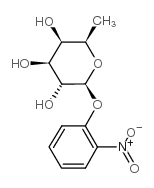4-硝基苯-BETA-D-吡喃半乳糖苷

4-硝基苯-BETA-D-吡喃半乳糖苷结构式

|
常用名 | 4-硝基苯-BETA-D-吡喃半乳糖苷 | 英文名 | 2-nitrophenyl β-D-fucoside |
|---|---|---|---|---|
| CAS号 | 1154-94-5 | 分子量 | 285.25000 | |
| 密度 | 1.503g/cm3 | 沸点 | 506.2ºC at 760mmHg | |
| 分子式 | C12H15NO7 | 熔点 | N/A | |
| MSDS | 美版 | 闪点 | 260ºC |
|
A closer view of the conformation of the Lac repressor bound to operator.
Nat. Struct. Biol. 7(3) , 209-14, (2000) Crystal structures of the Lac repressor, with and without isopropyithiogalactoside (IPTG), and the repressor bound to operator have provided a model for how the binding of the inducer reduces the affinity of the repressor for the operator. However, because of... |
|
|
Thermal denaturation of the core protein of lac repressor.
Biochemistry 24(15) , 3842-6, (1985) The thermal denaturation of the core protein of lac repressor was studied alone and in the presence of the inducer isopropyl beta-D-thiogalactoside (IPTG) and the antiinducer o-nitrophenyl beta-D-fucoside (ONPF) by means of high-sensitivity differential scann... |
|
|
Escherichia coli lac repressor-lac operator interaction and the influence of allosteric effectors.
J. Mol. Biol. 265(1) , 1-7, (1997) The wild type E. coli lac operator is embedded in a 35 base-pair DNA sequence containing extensive 2-fold symmetry, suggesting a symmetric repressor operator complex. However, deviations from strict 2-fold symmetry occur at the central base-pair and at three ... |
|
|
Using networks to identify fine structural differences between functionally distinct protein states.
Biochemistry 43(34) , 10886-95, (2004) The vast increase in available data from the "-omics" revolution has enabled the fields of structural proteomics and structure prediction to make great progress in assigning realistic three-dimensional structures to each protein molecule. The challenge now li... |
|
|
Altering residues N125 and D149 impacts sugar effector binding and allosteric parameters in Escherichia coli lactose repressor.
Biochemistry 50(42) , 9002-13, (2011) Lactose repressor protein (LacI), a negative transcriptional regulator in Escherichia coli, relies on an allosteric conformational change for its function. The LacI effector isopropyl-β,D-thiogalactoside (IPTG) promotes this allosteric response and engages th... |
|
|
Ligand interactions with lactose repressor protein and the repressor-operator complex: the effects of ionization and oligomerization on binding.
Biophys. Chem. 126(1-3) , 94-105, (2007) Specific interactions between proteins and ligands that modify their functions are crucial in biology. Here, we examine sugars that bind the lactose repressor protein (LacI) and modify repressor affinity for operator DNA using isothermal titration calorimetry... |